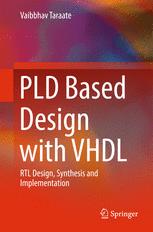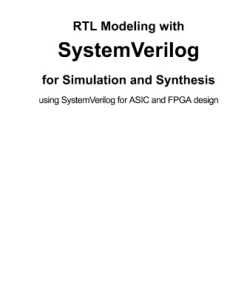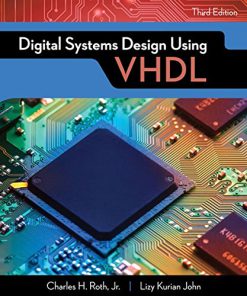PLD Based Design with VHDL RTL Design Synthesis and Implementation 1st Edition ISBN 9811032963 9789811032967
$50.00 Original price was: $50.00.$25.00Current price is: $25.00.
PLD Based Design with VHDL RTL Design, Synthesis and Implementation 1st Edition by Vaibbhav Taraate – Ebook PDF Instant Download/Delivery: 9811032963, 9789811032967
Full download PLD Based Design with VHDL RTL Design, Synthesis and Implementation 1st Edition after payment

Product details:
ISBN 10: 9811032963
ISBN 13: 9789811032967
Author: Vaibbhav Taraate
This book covers basic fundamentals of logic design and advanced RTL design concepts using VHDL. The book is organized to describe both simple and complex RTL design scenarios using VHDL. It gives practical information on the issues in ASIC prototyping using FPGAs, design challenges and how to overcome practical issues and concerns. It describes how to write an efficient RTL code using VHDL and how to improve the design performance. The design guidelines by using VHDL are also explained with the practical examples in this book. The book also covers the ALTERA and XILINX FPGA architecture and the design flow for the PLDs. The contents of this book will be useful to students, researchers, and professionals working in hardware design and optimization. The book can also be used as a text for graduate and professional development courses.
PLD Based Design with VHDL RTL Design, Synthesis and Implementation 1st Table of contents:
1.1 History of HDL
1.2 System and Logic Design Abstractions
1.3 ASIC Prototyping
1.4 Integrated Circuit Design and Methodologies
1.4.1 RTL Coding
1.4.2 Functional Verification
1.4.3 Synthesis
1.4.4 Physical Design
1.5 Programming Language Verses HDL
1.5.1 VHDL Evolution and Popularity
1.6 Design Description Using VHDL
1.6.1 Structural Design
1.6.2 Behavior Design
1.6.3 Synthesizable RTL Design
1.7 Key VHDL Highlights and Constructs
1.8 Summary
2 Basic Logic Circuits and VHDL Description
Abstract
2.1 Introduction to Combinational Logic
2.2 Logic Gates and Synthesizable RTL Using VHDL
2.2.1 NOT or Invert Logic
2.2.2 Two-Input OR Logic
2.2.3 Two-Input NOR Logic
2.2.4 Two-Input AND Logic
2.2.5 Two-Input NAND Logic
2.2.6 Two-Input XOR Logic
2.2.7 Two-Input XNOR Logic
2.2.8 Tri-State Logic
2.3 Adder
2.3.1 Half Adder
2.3.2 Full Adder
2.4 Code Converters
2.4.1 Binary-to-Gray Code Converter
2.4.2 Gray-to-Binary Code Converter
2.5 Summary
3 VHDL and Key Important Constructs
Abstract
3.1 VHDL Design Paradigm
3.2 Multiple Architectures and Configuration
3.2.1 Multiple Architecture and Configuration
3.3 Objects and Data Types
3.3.1 Scalar Data Types
3.3.1.1 Enumerated Data Types
3.3.1.2 Integer Data Types
3.3.1.3 Physical Data Types
3.3.1.4 Real Data Type
3.3.2 Composite Data Types
3.3.2.1 Arrays
3.3.2.2 Records
3.3.3 Data Objects
3.3.4 Constants
3.3.4.1 Variable
3.3.4.2 Signal
3.3.4.3 File
3.4 Signal Assignments
3.4.1 Signal Assignments Example
3.5 Variable Assignment
3.5.1 Variable Assignments Example
3.6 Concurrent Constructs
3.6.1 When Else
3.6.2 With Select
3.6.3 Process
3.7 Sequential Constructs
3.7.1 If Then Else
3.7.2 Nested If Then Else
3.7.3 Case
3.8 Modeling Sequential Logic
3.8.1 Four-Bit Register
3.8.2 Four-Bit Latch
3.9 Wait Statements
3.9.1 Wait On
3.9.2 Wait For
3.9.3 Wait Until
3.10 Loops
3.10.1 Loop
3.10.2 While Loop
3.10.3 For Loop
3.11 Summary
References
4 Combinational Logic Design Using VHDL Constructs
Abstract
4.1 Combinational Logic and Delays
4.1.1 Cascade Combinational Logic
4.1.2 Parallel Combinational Logic
4.2 Arithmetic Circuits
4.2.1 Multibit Adder
4.2.2 Multibit Adder–Subtractor
4.2.3 Multiplier
4.2.4 Comparators
4.3 Code Converter
4.3.1 Binary-to-Excess-3 Code Converter
4.3.2 BCD-to-Seven-Segment Decoder
4.4 Multiplexers
4.4.1 Multiplexer as Universal Logic
4.4.1.1 2:1 MUX
4.4.1.2 4:1 MUX Using Nested ‘If Then Else’
4.4.1.3 4:1 MUX Using ‘Case’ Construct
4.5 Decoders
4.5.1 3 Line to 8 Decoder with Enable Using ‘Case’
4.5.2 2 Line to 4 Decoder with Enable Using ‘Case’
4.6 Encoders
4.6.1 Priority Encoders
4.7 Summary
5 Sequential Logic Design
Abstract
5.1 Sequential Logic
5.1.1 Metastability and Timing Parameters for the Sequential Logic
5.1.1.1 Setup Time
5.1.1.2 Hold Time
5.1.1.3 Propagation Delay of Flip-Flop
5.2 D-Latches in the Design
5.2.1 Positive Level Sensitive D-Latch
5.2.2 Negative Level Sensitive D-Latch
5.2.3 Negative Level Sensitive D-Latch with Preset and Clear
5.2.4 Positive Level Sensitive D-Latch with Asynchronous Preset and Clear
5.3 Flip-Flop
5.3.1 Positive Edge-Triggered D Flip-Flop
5.3.2 Negative Edge-Triggered D Flip-Flop
5.4 Synchronous and Asynchronous Reset
5.4.1 D Flip-Flop with Asynchronous Reset
5.4.2 D Flip-Flop with Synchronous Reset
5.5 Sequential Circuit Timing
5.6 Synchronous Counters
5.6.1 Four-Bit Up Counter
5.6.2 Four-Bit Down Counter
5.6.3 BCD Up Counter
5.6.4 BCD Down Counter
5.6.5 BCD Up–Down Counter
5.7 Gray Counter
5.8 Ring Counter
5.9 Johnson Counter
5.10 Shift Registers
5.10.1 Right and Left Shift Registers
5.10.2 Parallel Input, Parallel Output (PIPO) Shift Register
5.11 Asynchronous Designs
5.12 Summary
6 Introduction to PLD
Abstract
6.1 History and Evolution of PLDs
6.2 Simple Programmable Logic Device (SPLD)
6.2.1 Programmable Read-Only Memory (PROM)
6.2.2 Programmable Array Logic (PAL)
6.2.3 Programmable Logic Array (PLA)
6.3 Complex Programmable Logic Devices
6.4 Field-Programmable Gate Arrays
6.4.1 Concept of LUT and Combinational Logic Realization
6.4.2 VHDL Design and Realization Using CLB
6.4.3 IO Block
6.4.4 Block RAM (BRAM)
6.4.5 Clocking Resources
6.4.5.1 Data and Clock Paths and Use of Clock Buffers
6.4.6 DSP Blocks and Multipliers
6.4.7 Routing Resources and IO Standards
6.5 Practical Scenarios and Guidelines
6.5.1 Reset Strategy
6.5.1.1 Synchronous Reset
6.5.1.2 Asynchronous Reset
6.5.2 Asynchronous Versus Synchronous Designs
6.5.3 Clocking Strategies
6.5.3.1 Single Master Clock
6.5.3.2 Ripple Counters
6.5.3.3 Mix Edge Clocking
6.5.3.4 Gated Clocks
6.6 Summary
7 Design and Simulation Using VHDL Constructs
Abstract
7.1 Simulation Using VHDL
7.1.1 Testbench for 4:1 MUX
7.1.2 Testbench for 4-Bit Binary up Counter
7.2 Functions
7.3 Packages
7.3.1 Package Use in Design
7.4 Attributes
7.4.1 Signal Attribute
7.4.2 Array Attribute
7.5 File Handling
7.5.1 Use of Files in Design Simulation
7.5.2 TEXTIO
7.6 Summary
8 PLD-Based Design Guidelines
Abstract
8.1 Naming Conventions
8.2 Use of Signals and Variables
8.3 Grouping in Design
8.4 Guidelines for Use of Tri-State Logic
8.5 Arithmetic Resource Sharing
8.6 Logic Duplications
8.7 Multiple Driver Assignments
8.8 Inferring Latches
8.9 Use of If Then Else Versus Case Statements
8.10 Use of Pipelining in Design
8.11 Multiple Clock Domain and Data Passing
8.12 Bidirectional IO
8.13 Gated Clock
8.14 Design with Clock Enable
8.15 Summary
9 Finite-State Machines
Abstract
9.1 Introduction to FSM
9.1.1 Moore Machine
9.1.2 Mealy Machine
9.2 FSM Encoding Methods
9.3 How to Code Moore FSM Using VHDL?
9.3.1 FSM Design Template for Moore Machine
9.4 How to Code Mealy FSM Using VHDL?
9.4.1 FSM Design Template for Mealy Machine
9.5 FSM Examples and VHDL Coding
9.5.1 Binary Encoding FSM
9.5.2 Binary Counter FSM
9.5.3 One-Hot Counter FSM
9.6 Parity Logic Using Moore FSM
9.6.1 Moore Machine: Three-Process Block FSM for Parity Checking
9.7 Parity Logic Using Mealy FSM
9.7.1 Mealy Machine: Two-Process Block FSM for Parity Checking
9.7.2 Mealy Machine: Three-Process Block FSM for Parity Checker
9.8 Sequence Detector Mealy Machine
9.9 One-Hot Encoding Sequence Detector: Moore Machine
9.10 One-Hot Encoding Sequence Detector: Mealy Machine
9.11 FSM Optimization
9.12 Summary
10 Synthesis Optimization Using VHDL
Abstract
10.1 FPGA Design Flow
10.1.1 Design Entry
10.1.2 Design Simulation and Synthesis
10.1.3 Design Implementation
10.1.4 Device Programming
10.2 Synthesis Optimization Techniques
10.2.1 Resource Allocation
10.2.2 Common Factors and Subexpressions Used for Optimization
10.2.3 Moving the Piece of Code
10.2.4 Constant Folding
10.2.5 Dead Zone Elimination
10.2.6 Use of Parentheses
10.2.7 Partitioning and Structuring the Design
10.3 ALU Design
10.3.1 Processor Logic Unit and Design
10.3.1.1 8-bit Logic Unit
10.3.1.2 Processor Logic Unit with Registered IO
10.3.2 Arithmetic Unit
10.3.3 Arithmetic and Logical Unit
10.4 Barrel Shifters
10.5 Parity Checkers and Generators
10.5.1 Parity Checker
10.5.2 Parity Generator
10.6 Memories
10.6.1 Single-Port RAM
10.6.2 Dual-Port RAM
10.7 Multipliers
10.8 Summary
References
11 Design Implementation Using Xilinx Vivado
Abstract
11.1 Design Implementation Case_Study Using Xilinx Vivado
11.1.1 Design Planning
11.1.2 IO Planning and IO Constraints
11.1.3 Functional Simulation of the Design
11.1.4 Design Synthesis
11.2 Design Implementation
11.2.1 Timing Simulation
11.3 FPGA Board Bring-up
11.4 FIFO Design Case Study
11.4.1 Asynchronous FIFO Depth Calculations
11.4.2 FIFO Design Using VHDL
11.5 Summary
People also search for PLD Based Design with VHDL RTL Design, Synthesis and Implementation 1st:
pld based design with vhdl
vhdl design patterns
simple vhdl example
designing with vhdl
modern digital designs with eda vhdl and fpga pdf
Tags:
Vaibbhav Taraate,PLD Based Design,VHDL,RTL Design,Synthesis and Implementation
You may also like…
Computers - Computer Graphics & Design
Housekeeping & Leisure - Interior Design & Decoration
Database Design and Implementation 2nd Edition Edward Sciore 3030338363 9783030338367
Computers - Hardware
Digital Systems Design Using VHDL 3rd Edition Charles H. Roth
Computers - Hardware












